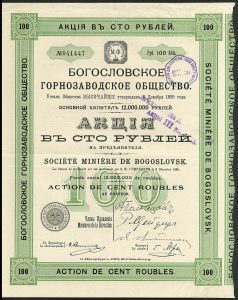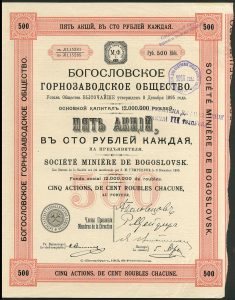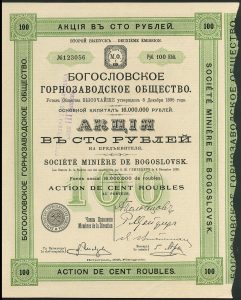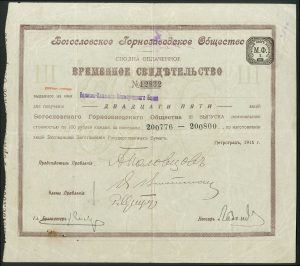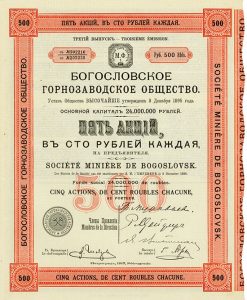
Société Minière de Bogoslovsk
Богословское Горнозаводское Общество
Theological Mining Society
Other city spellings: St.-Pétersbourg, Petrograd, Pétrograde
Formed in 1895 with head office in St. Petersburg. Initial capital was 8,000,000 roubles in shares of 250 roubles. By 1913, capital had increased to 12,000,000 roubles in shares of 100 roubles. Capital by 1916 had reached 16,000,000 roubles and in 1917 increased to 24,000,000 roubles.
1895
Description
This large iron-making producter of the future Theological Mining Society was founded by the Verkhoturye merchant Pokhodyashin after iron and copper ores were found in the Sosva River basin. The plant, which also included copper-smelting and chemical production, was at first called Turinsky, and then, after the construction of the church in honor of John the Theologian, it became known as Bogoslovsky. The Society also included the Nadezhda ironworks, steel rail and sawmills, the Sosva iron and steel works, and the Polevskoy plant. In addition to the mines that delivered copper and iron ore to the enterprises, the Society had numerous gold and platinum mines, brown coal mines, a power plant, its own wharfs and steamships.
In 1884, the Bogoslovsky Mining District was sold to Nadezhda Mikhailovna Polovtsova (adopted daughter of the court banker A.L. Stieglitz, “Association of the Narva Flax-Spinning Manufactory, the former flax-spinning factory of Baron A.L. Stieglitz”). “The Sovereign Emperor, in accordance with the position of the Committee of Ministers, the highest command deigned to allow the wife of the Secretary of State of His Imperial Majesty Actual Privy Councillor, Nadezhda Mikhailovna Polovtsova, to establish a joint-stock company under the name “Theological Mining Society” on the basis of a charter awarded by the Highest consideration and approval in Tsarskoye Selo on 8 December day, 1895.
The fixed capital of the Company amounted to 8 million rubles in gold, divided into 32,000 shares, 250 gold rubles each. The following enterprises were transferred to the Theological Mining and Plant Society: Nadezhda Metallurgical (3300 workers), Sosva iron-smelting (1177 workers) and Bogoslovsky copper-smelting (1100 workers) plants; copper, manganese, iron and chromium iron mines; gold and platinum mines; coal and white clay mines; shipping company on the Ob River with 8 steam tugs and 26 barges; inter-factory railway.
From 1881, the Theological Mining District was successfully managed by a hereditary nobleman, a real state councilor, a professor at the St. Petersburg Mining Institute, Alexander Andreevich Auerbakh (the “mercury” king of Russia). He described his activities in the article: “On the development of mining business in the Bogoslovsky District from 1881 to 1888” (“Mining Journal”, 1888).
In 1900, due to the economic crisis, the situation of the Company’s enterprises worsened. In 1905, a provisional administration was established for the company. As a result of her decisions, the staff of employees was reduced, the issuance of apartment money to workers and employees was canceled, a 5% increase in wages was eliminated, and reduced prices were introduced in the blast furnace and rolling shops. In 1917, the fixed capital was increased to 36 million rubles, but the revolution interrupted the activities of the Society. (Source: Scripophily.Ru)

